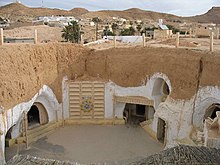Ben Brownell wrote:Interesting links Kevin! Thanks for that diversion. Led me to this excellent looking (didn't watch yet) documentary film surrounding several inventive projects in 60s Cuba:
https://www.ajnafilms.com/work/unfinishedspaces
You're welcome.
I have a "thing" for thin tile vaults - actually, for masonry vaults and domes, in general, but tile vaults, in particular - though I haven't built any, yet, not even small scale models. However, I did briefly correspond via email a few years ago with Anne Fitchett, who designed the structural tile for the Mapungubwe visitor's center project. In that case, they site mixed, pressed and cured the tiles using a slightly modernized manual CINVA-style press, with hardboard separators between tiles, so that they could press 3 tiles for each cycle of the press. This layer cake approach gave the correct thickness of the entire assemblage to allow for proper compression of the tiles. The tiles were stabilized with Portland cement, and cured. (Under plastic sheeting? I forget, now. But, it's quite dry there, so I'm sure they needed to take steps to prevent excessive drying before the cure was complete.) I don't recall the percentage of OPC used, but that would vary, depending on the local mineral soil being used, in any case. The Mapungubwe tile-making process was quite labor intensive, but that wasn't considered detrimental in that project, since high labor provided more employment for more people for a longer period of time. If I recall correctly, at least some of the pay was in cooking oil, maize meal and other foodstuff.
The manual Auram compressed earth block press seems ideal for pressing carefully engineered components like structural tiles, since the compression ratio is adjustable and highly repeatable, and it is built to take interchangeable dies. But, the Auram press is not cheap, even the fully manual version, and it is apparent that the CINVA style press is adequate with reasonable care and can be cheaply locally manufactured.
It ought to be possible to use other stabilizer chemistries than OPC for tiles which are cured rather than fired (or, perhaps are only low fired - essentially baked). Lime may be possible, even if slow to cure (but also tends to be self-healing of small cracks). If using lime, hot mixes may be useful. Some of the geopolymer binders also seem promising, including the "low temperature geopolymer setting" (LTGS) chemistry of Davidovits, which can be cured to reasonable compressive strengths at the sort of temperatures reach under black plastic in the summer sun. But, I need to brush up on my chemistry, or co-opt one of my cronies into assisting.
Guastavino introduced the use of Portland cement based mortars into timbrel vault construction when he was still working in Catalonia, which sped up construction, but prior to that, lime mortars had been used, all the way back to the High Middle Ages when this tech first appeared (or, at least, the earliest I'm aware of it being used).
I think this tried and true technology has much promise for lower cost underground structures (cisterns under courtyards or wine cellars under kitchens, wofatis and hobbit holes, root cellars, tunnels for qanats and aquaducts, toilet vaults, etc.) and for above ground applications (flat roofed portions of a residence with rooftop gardens, or intermediate floors for multistory buildings, Yemeni high rise style, for example). It seems like it would be a good complement to rammed earth or compressed earth block. Though, it might require a bit more care if used with adobe, since the compressive strength of adobe is quite low - avoiding concentrated loads at the springing and supporting thrust loads would be key, I suspect. Not insurmountable, but requiring some forethought.
I've probably high-jacked this thread enough, so I'll cease and desist.
And, thanks for the link to the film. I wasn't aware of this one. Looks like good stuff.





 4
4




![Filename: inside-dance-floor-compass-3.jpg
Description: [Thumbnail for inside-dance-floor-compass-3.jpg]](/t/272374/a/257704/inside-dance-floor-compass-3.jpg)
 2
2





![Filename: yep.jpg
Description: [Thumbnail for yep.jpg]](/t/272374/a/257773/yep.jpg)
 5
5




 7
7




 5
5




 7
7




 2
2




![Filename: framing-rafters-cieling-joists-trusses.jpg
Description: [Thumbnail for framing-rafters-cieling-joists-trusses.jpg]](/t/272374/a/258845/framing-rafters-cieling-joists-trusses.jpg)
 1
1




 5
5




 4
4





















